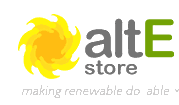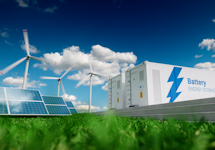What is battery storage?
Battery energy storage systems are a key part of switching to renewable energy, such as solar and wind power, and they enable customers to access the stored energy when it's needed. BESSs make use of advanced technologies that allow them to store energy for later use. Lithium-ion batteries are typically employed for industrial, commercial, or residential applications at large scale plants and also in smaller home applications. Utilizing battery storage systems ensures a continuous source of renewable energy can be accessed.
What are the benefits of a battery energy storage system?
Battery systems are vital for utilities, businesses and homes to ensure a continual power flow in case of fluctuations due to weather, blackouts, or geopolitical reasons. Battery storage technology enables renewable energy sources to become more dependable and usable. Battery storage can be used for commercial and industrial applications such as peak shaving, load shifting, and integration with renewable energy sources. Residential users benefit from battery storage applications by self consumption, emergency backup in the event of a blackout, and going off the grid. Battery storage can provide a smooth and continuous electricity flow in the absence of power from renewables.
Battery storage systems are increasingly becoming an important part of the energy market. These systems allow users to store excess energy and use it when needed. By doing so, they can save on their electricity costs while also contributing to a cleaner energy grid. The basic principle of a battery storage system is energy arbitrage. This means that users can buy energy when the price is low and store it in their battery system. Then, when the price increases, they can use the stored energy instead of buying more expensive power from the grid. Energy arbitrage is a key component of reducing electricity costs while also increasing access to clean energy. Battery storage systems allow users to store their excess energy and use it when needed, helping to reduce their overall energy costs.
How do battery storage systems work?
A battery storage system is a complex setup of components that work together to store energy for later use.
The most common components are:
Batteries: Batteries are the most crucial part of a battery storage system. They store energy in chemical form and can then release it as electricity when needed. Different types of batteries have different energy storage capacities and can be used to power everything from small electric vehicles to large-scale energy demand.
Inverters: An inverter is an electronic device that converts direct current (DC) into alternating current (AC). Inverters are used to convert the energy stored in the battery into usable AC power. This is necessary for powering many household appliances and devices.
Charge Controllers: Charge controllers regulate the rate at which energy is transferred to and from the batteries. This is important for ensuring safe operation and preventing damage to the battery cells.
Monitoring Devices: Monitoring devices measure the voltage, current, and temperature of the battery cells. This data can then be used to optimize system performance and detect any potential issues with the battery.
Battery Management System (BMS): A BMS is an advanced computerized system that regulates the charging and discharging of the batteries. It can also be used to monitor the health of the batteries and balance the charge between cells.
These are the main components of a battery storage system, but other components such as fuse boxes, transformers, and surge protectors may also be used depending on the application. By understanding how these components work together, you can ensure that your battery storage system is working properly and efficiently. The altE Energy Storage Kits have nearly everything you'll need to install a residential or commercial battery energy storage system.
What is UL9540?
UL9540 is a new safety standard for an Energy Storage System, where the equipment in the system is intended for connection to a local utility grid or standalone application. It designates key safety issues including: safety of the battery component, fire detection and suppression, and potential environmental hazards. A UL9540 energy storage system is comprised of UL 1973-certified stationary battery pack(s), and a UL 1741-certified inverter(s). Rigorous thermal and electrical testing and evaluation of the UL listed components, together as a system, is performed to ensure they are integrated into a safe, high-performance system.
How do I size an energy storage system?
The right energy storage technology can be the difference between productive projects, a reliable source of power, and costly downtime. But with so many options on the market it is difficult to decide which one to choose. To make sure you select the best energy storage technology for your needs, here’s a list of things to consider:
- Identify Your Energy Storage Needs
Before selecting any technology or solution you need to clearly identify and analyze your energy usage and needs to determine what type of activities or services an energy storage device would best meet. With these needs in mind, evaluate the size and duration of the charge/discharge cycle along with cost considerations, scalability, safety requirements, project location restrictions, and temperature requirements.
- Consider Application Size
The size and capacity of a storage system are important factors when considering applications such as renewable generation integration, peak shaving operations (time shifting) or battery backup. Choose devices that are compatible with each other so they’re able to couple up easily, or simply choose one of the predesignated kits offered by altE.
- Evaluate Relevant Technologies and Research Manufactures
It is necessary that you take time to thoroughly research manufactures who supply energy storage solutions so that you have confidence in the reliability of your end product and its performance over time. You should ensure their products have all relevant certifications for operation. All of the energy storage system kits on this page have UL9540 certification.
You need to evaluate the more prominent technologies within this sector. The altE energy storage system kits feature parts from Enphase, KiloVault, Outback, SimpliPhi, Sol-Ark and Schneider. All of the systems include lithium ion batteries and hybrid inverters. These kits do not include solar, but are capable of integrating existing or future solar electric systems. If you are looking for a package that includes solar panels, check out our Battery Backup Solar Power Systems.
- Compare System Costs
A key factor when selecting an appropriate system is comparing all cost components including installation costs and lifetime maintenance costs, dependent upon application lifespan. It is important to weigh up upfront investments against potential revenue. Some installations may be subsidized depending upon application strategy and be eligible for tax credits.
- Conduct a Site Assessment
Look at factors such as available space, electrical distribution detail on site, wiring specifications, accessibility for repair works, and assess competency levels relative to installation complexity.



